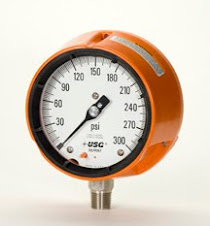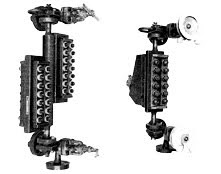Honeywell Process Equipment has written the below white paper on the effects of "Hydrogen Permeation - Galvanic Reaction", This paper describes a potential problem and the solution for "Process Transmitters" being used in Hydrogen applications. I hope you find this article to be educational. And just maybe it might shed some light on problem applications you might be experiencing within your plant.
Hydrogen Permeation – Galvanic Reaction
Introduction
Hydrogen (H) is the simplest and smallest atom element in nature. Water, acids, bases, and the entire family of organic compounds all contain hydrogen. While hydrogen is not considered corrosive, it can cause problems with pressure transmitters if the application is not properly evaluated. Pressure transmitters with close coupled zinc- or cadmium-plated components that are used where water is the process medium, in part or in whole, are commonly susceptible to hydrogen migration.
Hydrogen is normally found as in a diatomic state as a molecule composed of two hydrogen atoms (H2). In this state, molecules will not penetrate the thin metal barrier diaphragms. However, if the hydrogen splits into two hydrogen ions (H+ atoms), it can penetrate barrier diaphragms because H+ ions are smaller than the space between the molecules of the barrier diaphragm metal.
The source of the hydrogen gas (H2) significantly influences the way migration affects a transmitter. The worst possible case is where (H2) is cathodically generated on the face of the diaphragm. All it takes to create a galvanic cell is a weak electrolyte (water serves very well) coupled with zinc- or cadmium-plated transmitter flanges, a galvanized pipe, or fittings near the stainless steel diaphragm.
Zinc or cadmium plating serves as limited but significant types of corrosion protection when the base metal cannot provide the needed protection. For applications that do not require maximum protection, zinc or cadmium offers an inexpensive solution. Due to environmental protection limitations, cadmium is no longer offered and zinc is now mainly used.
Zinc is applied as a thin coating sufficient to withstand normal atmospheric corrosion. However, its resistance to corrosion by most chemicals is low. Zinc acts as a sacrificial anode. This means the underlying metal is protected at the expense of the zinc plating ― even when the zinc plating is scratched or nicked, exposing the metal substrate.
A potential difference results when the electrically connected zinc-plated heads or galvanized piping (anode) and the positive diaphragm (cathode) are separated in a conductive medium (water). This potential difference causes positively charged particles to flow from the anode to the cathode through the conductive medium. To complete the circuit, the negatively charged electrons flow from the anode to the cathode through the metal-to-metal contact between the heads and diaphragm.
The loss of electrons by the zinc plating is called oxidation, and it causes the metal to become positively charged. The positively charged ions on the surface (Zn++) attract negative ions found in the aqueous process to form new compounds. This new compound no longer has its former metallic characteristic, but rather takes on a new form, such as zinc oxide (ZnO2). The gain of electrons at the diaphragm is referred to as reduction and allows the metal to retain its metallic properties while liberating monatomic hydrogen (H-) and oxygen (O) in the process. Some of the monatomic hydrogen (H-) migrates through the diaphragm; the remainder combines to form hydrogen gas (H2), which bubbles away harmlessly.
After passing through the barrier diaphragms, H+ ions will re-combine into H2 molecules, which become trapped. Gradually the H2 molecules dissolve into the transmitter’s fill fluid, and over time the fill fluid becomes saturated. The concentration of trapped H2 depends on the operating pressure (static pressure) of the system and the temperature. The moment the static pressure is relieved, the trapped H2 gas expand and a bubble appears.
Hydrogen gas trapped inside a transmitter causes zero and span shifts over time as the trapped gas increases degrading performance of the transmitter. As the hydrogen gas builds up, it causes outward expansion (‘bulging’) of the barrier diaphragms, leading to cracks and transmitter failure through the loss of fill fluid.
A typical pressure transmitter diaphragm measures 0.002 inches (0.025 to 0.050 mm) thick. If the permeation continues long enough, permanent distortion of the diaphragm takes place as the diaphragm continues to expand.
This distortion is most evident and damaging once the static or operating pressure is relieved from the transmitter with the trapped (H2) still at the static pressure behind the diaphragm. The trapped hydrogen gas occupies a greater volume than the liquid fill fluid and ‘bulges’ or ‘blows-out’ the diaphragm.
Applications
Where to watch for galvanic H2 permeation? Water applications with galvanized process heads, impulse piping, 2/3-way manifolds, fittings, valves, etc. in the process are the obvious sources of hydrogen permeation. Water applications include steam or steam generating applications.
However, hydrogen permeation can occur in applications where water is not the main component present in its liquid form. Water in its vapor form as moisture can lead to the same problems when the vapor condenses. This can include combustion-air or compressed-air applications where moisture is present in the air. Water vapor condensing out due to compression or temperature changes collects inside a transmitter and leads to the same problems.
Diaphragm Materials
Diaphragm metal material affects the rate of hydrogen permeation because molecular lattice spacing is different in each metal. The nickel (Ni) content of the metal also affects the rate of hydrogen permeation. While not totally understood, the rate of hydrogen permeation increases exponentially with the nickel content.
Stainless steel has the lowest nickel content and is the diaphragm material of choice for most applications. Nickel-based metals, like Hastelloy C-276 and Monel, should be avoided as well as Tantalum.
Solutions and Prevention
Although expensive, gold-plating the barrier diaphragms offers the best protection. A thin layer (0.00012 inch (3 μm) thick) of 99.9% pure gold virtually eliminates hydrogen permeation without itself being affected by the process. However, do not use gold plating to enhance resistance to corrosion. The gold plating is too thin and too porous to provide an effective barrier to corrosion.
Hydrogen Permeation – Galvanic Reaction
Introduction
Hydrogen (H) is the simplest and smallest atom element in nature. Water, acids, bases, and the entire family of organic compounds all contain hydrogen. While hydrogen is not considered corrosive, it can cause problems with pressure transmitters if the application is not properly evaluated. Pressure transmitters with close coupled zinc- or cadmium-plated components that are used where water is the process medium, in part or in whole, are commonly susceptible to hydrogen migration.
Hydrogen is normally found as in a diatomic state as a molecule composed of two hydrogen atoms (H2). In this state, molecules will not penetrate the thin metal barrier diaphragms. However, if the hydrogen splits into two hydrogen ions (H+ atoms), it can penetrate barrier diaphragms because H+ ions are smaller than the space between the molecules of the barrier diaphragm metal.
The source of the hydrogen gas (H2) significantly influences the way migration affects a transmitter. The worst possible case is where (H2) is cathodically generated on the face of the diaphragm. All it takes to create a galvanic cell is a weak electrolyte (water serves very well) coupled with zinc- or cadmium-plated transmitter flanges, a galvanized pipe, or fittings near the stainless steel diaphragm.
Zinc or cadmium plating serves as limited but significant types of corrosion protection when the base metal cannot provide the needed protection. For applications that do not require maximum protection, zinc or cadmium offers an inexpensive solution. Due to environmental protection limitations, cadmium is no longer offered and zinc is now mainly used.
Zinc is applied as a thin coating sufficient to withstand normal atmospheric corrosion. However, its resistance to corrosion by most chemicals is low. Zinc acts as a sacrificial anode. This means the underlying metal is protected at the expense of the zinc plating ― even when the zinc plating is scratched or nicked, exposing the metal substrate.
A potential difference results when the electrically connected zinc-plated heads or galvanized piping (anode) and the positive diaphragm (cathode) are separated in a conductive medium (water). This potential difference causes positively charged particles to flow from the anode to the cathode through the conductive medium. To complete the circuit, the negatively charged electrons flow from the anode to the cathode through the metal-to-metal contact between the heads and diaphragm.
The loss of electrons by the zinc plating is called oxidation, and it causes the metal to become positively charged. The positively charged ions on the surface (Zn++) attract negative ions found in the aqueous process to form new compounds. This new compound no longer has its former metallic characteristic, but rather takes on a new form, such as zinc oxide (ZnO2). The gain of electrons at the diaphragm is referred to as reduction and allows the metal to retain its metallic properties while liberating monatomic hydrogen (H-) and oxygen (O) in the process. Some of the monatomic hydrogen (H-) migrates through the diaphragm; the remainder combines to form hydrogen gas (H2), which bubbles away harmlessly.
After passing through the barrier diaphragms, H+ ions will re-combine into H2 molecules, which become trapped. Gradually the H2 molecules dissolve into the transmitter’s fill fluid, and over time the fill fluid becomes saturated. The concentration of trapped H2 depends on the operating pressure (static pressure) of the system and the temperature. The moment the static pressure is relieved, the trapped H2 gas expand and a bubble appears.
Hydrogen gas trapped inside a transmitter causes zero and span shifts over time as the trapped gas increases degrading performance of the transmitter. As the hydrogen gas builds up, it causes outward expansion (‘bulging’) of the barrier diaphragms, leading to cracks and transmitter failure through the loss of fill fluid.
A typical pressure transmitter diaphragm measures 0.002 inches (0.025 to 0.050 mm) thick. If the permeation continues long enough, permanent distortion of the diaphragm takes place as the diaphragm continues to expand.
This distortion is most evident and damaging once the static or operating pressure is relieved from the transmitter with the trapped (H2) still at the static pressure behind the diaphragm. The trapped hydrogen gas occupies a greater volume than the liquid fill fluid and ‘bulges’ or ‘blows-out’ the diaphragm.
Applications
Where to watch for galvanic H2 permeation? Water applications with galvanized process heads, impulse piping, 2/3-way manifolds, fittings, valves, etc. in the process are the obvious sources of hydrogen permeation. Water applications include steam or steam generating applications.
However, hydrogen permeation can occur in applications where water is not the main component present in its liquid form. Water in its vapor form as moisture can lead to the same problems when the vapor condenses. This can include combustion-air or compressed-air applications where moisture is present in the air. Water vapor condensing out due to compression or temperature changes collects inside a transmitter and leads to the same problems.
Diaphragm Materials
Diaphragm metal material affects the rate of hydrogen permeation because molecular lattice spacing is different in each metal. The nickel (Ni) content of the metal also affects the rate of hydrogen permeation. While not totally understood, the rate of hydrogen permeation increases exponentially with the nickel content.
Stainless steel has the lowest nickel content and is the diaphragm material of choice for most applications. Nickel-based metals, like Hastelloy C-276 and Monel, should be avoided as well as Tantalum.
Solutions and Prevention
Although expensive, gold-plating the barrier diaphragms offers the best protection. A thin layer (0.00012 inch (3 μm) thick) of 99.9% pure gold virtually eliminates hydrogen permeation without itself being affected by the process. However, do not use gold plating to enhance resistance to corrosion. The gold plating is too thin and too porous to provide an effective barrier to corrosion.
The correct choice of metals affords the best prevention in aqueous applications. The following guidelines may be useful. However, Honeywell provides no assurances or guarantees as to their appropriateness in a specific application. It is customer experience that is paramount.
• Do not use Hastelloy diaphragms with zinc-plated carbon steel process heads. Zinc is extremely anodic compared to the highly cathodic Hastelloy and rapid zinc corrosion can release excessive hydrogen ions and initiate rapid ion migration.
• Do not use zinc-plated carbon steel process heads with stainless steel diaphragms. Stainless steel process heads should be used for this application.
• Gold plate the diaphragms whenever hydrogen ion migration is a threat.
wpdf5233 ©Honeywell International Inc., 2003





















No comments:
Post a Comment